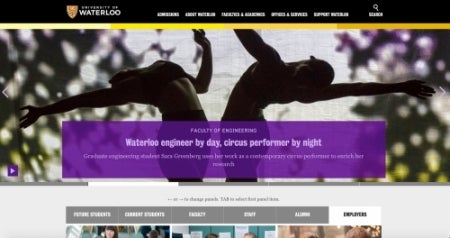Last updated: August 14, 2025
The Waterloo logo is one of the most important elements of our brand identity. As a key visual signifier, it represents our promise to challenge, connect and propel the world’s innovators.
The logo inspires pride, loyalty and connection among our students, staff, faculty and alumni. And, for many, it is their first introduction to the Waterloo brand.
As such, the logo is to be used properly, consistently and with pride. This page contains information about how to correctly use the official University logo.
Because Waterloo is composed of a number of faculties, departments, schools and other units, we also have a comprehensive logo architecture you can use to guide logo applications in various contexts.
Official logo versions
The official University logo has horizontal and vertical versions. Whenever possible, use the horizontal version.
While black-and-white reverse versions of the logos are available, you should use these only when colour printing is not an option.
Horizontal
The horizontal version of the Waterloo logo should be your go-to choice whenever appropriate for the layout.
The horizontal University of Waterloo logo.
Vertical
If the horizontal version of the logo isn’t optimal for a particular layout, you can use the vertical version.

The vertical University of Waterloo logo.
Shield
The official Waterloo shield, or coat of arms, contains symbolism that tells our history. The shield is a component of both the University logo and official seal.
Dating back to 1961, the shield uses our official colours of gold, black and white with double chevrons and three red lions. The imagery is derived from the coats of arms of two historic figures connected to Waterloo Region— Lord Kitchener and the Duke of Wellington. The colours reflect the Germanic heritage of the Region.
Modified use of the shield must be pre-authorized by the Associate Vice-President, Marketing and Brand Strategy.
The shield can not be separated from the "University of Waterloo" wordmark. See improper use for more information.
Seal
The University Seal contains the shield and the Waterloo motto, Concordia cum veritate, meaning “in harmony with truth.”
Approved use
While the seal is a part of our visual identity, it is reserved for official, ceremonial and heritage use (e.g., convocation materials and select merchandise).
Use of the official seal must be pre-authorized by the vice-president of University Relations or a designate. Do not modify the seal in any way or combine it with any other type or graphic.
Seal versions

The full-colour University seal.

The black-and-white University seal.

The black-screened University seal.
Minimum size and clear space
Making sure our logos meet sizing and spacing requirements guarantees they are always clear, legible and professional looking.
The following requirements apply to all logo formats in the logo architecture, including Waterloo faculty, department, school and non-academic logos.
Clear space
Clear space around the logo helps draw the eye and create visual impact. Follow these guidelines when placing the logo:
- Remember to take into account the white border around the shield.
- Make sure no other graphic element appears within the clear space.
- In the vertical version, if the name of the faculty, department, school or unit extends wider than the University text, measure the clear space from the widest portion of the logo.
Example: Horizontal
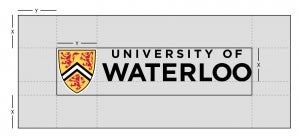
Required clear space around the horizontal University logo.
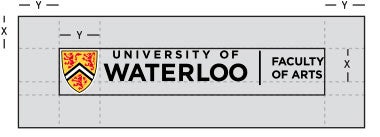
Required clear space around the horizontal faculty logo.
Example: Vertical
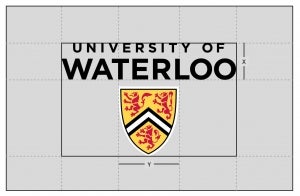
Required clear space around the vertical University logo.
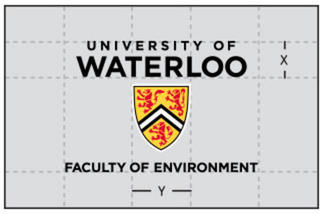
Required clear space around the horizontal faculty logo.
Minimum size
Follow minimum size requirements to ensure the logo is recognizable and easy to read. This means the logo may not be appropriate for use in certain small-scale applications.
Follow these guidelines when sizing the logo:
- Remember to take into account the white border around the shield.
- For the horizontal version, ensure the height of the shield is never less than 7.3 millimetres (mm) or 28 pixels (px).
- For the vertical version, ensure the full height of the primary logo is never less than 14.9 mm or 54 px.
Example: Horizontal

Place the horizontal logo on the left or right of the canvas. Place the vertical logo in the centre of the canvas.
Example: Vertical
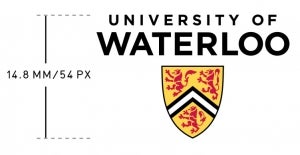
Place the horizontal logo on the left or right of the canvas. Place the vertical logo in the centre of the canvas.
Placement and positioning
It may seem like a small detail, but establishing brand consistency means being intentional about how we position the University logo, as well as faculty, department, school, partner and other co-brand logos.
Print applications
In print applications, place logos at the bottom (e.g., reports, viewbooks, posters). This rule may not apply if the logo needs to be more visible (e.g., zap banners, business cards).
The following examples show recommended logo placement. Click the sample images to view full-size versions.
University of Waterloo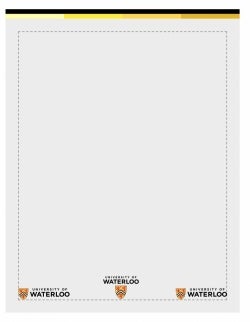
Place the horizontal logo on the left or right of the canvas. Place the vertical logo in the centre of the canvas.
Digital applications
In digital applications, place the University logo in the header and the faculty or partner logo in the footer. If the application is proprietary to the faculty or partner, you may instead place their logo at the top of the page.
The following examples show recommended logo placement. Click the sample images to view full-size versions.
Faculty

Place the horizontal University logo in the header and the faculty logo in the footer.
Advertising
In print and digital advertising, position logos at the bottom of the layout. Place the horizontal logo on the left or right and the vertical logo in the centre
Improper use
Modifying, altering or redrawing the logo in any way can have negative consequences for our reputation and brand recognition. The following examples show how not to use the University, faculty, school, department and non-academic logos.
This list is not meant to be exclusive. Any modification or improper use of the logo will not be permitted.
| Example of improper use | Description of improper use |
|---|---|
 |
Shield is positioned to the right of the horizontal wordmark, rather than to the left of the horizontal wordmark. |
 |
Logo has been re-sized disproportionately, resulting in a horizontal stretching of the shield and wordmark. |
 |
Logo has been re-sized disproportionately, resulting in a vertical stretching of the shield and wordmark. |
 |
Shield has been isolated and enlarged separately from the wordmark. |
 |
Wordmark has been re-coloured, rather than appearing in black or white. |
 |
Shield has been re-coloured. |
 |
Shield is positioned below the horizontal wordmark, rather than to the left of the horizontal wordmark. |
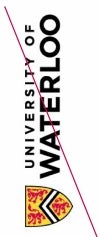 |
The logo has been rotated 90 degrees. This is allowed in certain instances, such as on merchandise (e.g., pens or water bottles), where the logo positioning supports brand objectives. |
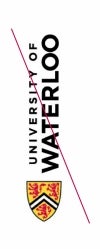 |
The wordmark has been rotated. |
| Please note: University Relations may grant exceptions to the official brand guidelines where it deems these measures are required for official business. These exceptions will be communicated in writing by a senior member of the University Relations Marketing and Brand team and may be rescinded at the University's discretion. | |

